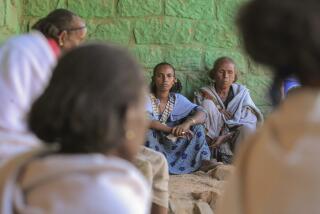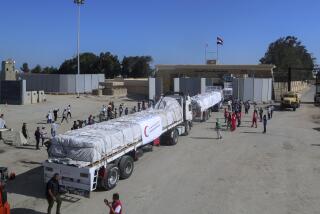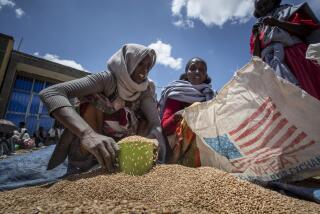Flight to Ethiopia: Food, Supplies, Compassion : Flying Tigers, Others Donate Money, Time to Starving Africans
ADDIS ABABA, Ethiopia — The American Boeing 747 had been flying south over Ethiopia for more than an hour, covering 600 miles from the Red Sea at the nation’s northernmost tip, across barren desert and bone-dry, rust-colored mountains indented with narrow, deep valleys.
Visible below were scattered settlements on high plateaus and in valleys where perhaps 200,000 people have died from famine in the last year alone, where thousands continue to starve and die each week in primitive huts or en route on the network of trails seeking help.
The incredible harshness of the landscape--not a sign of water or a patch of green--makes it remarkable that human life is possible there at all.
Capital Sighted
“There it is! There it is! Addis Ababa!” exclaimed Hal Ewing, 41, of Sumpter, S.C., captain of the Flying Tigers air freighter, as the 747 descended through puffy cumulus clouds. Ethiopia’s 7,625-foot-high capital suddenly burst into view amid a patchwork quilt of dry, brown farms .
The plane was on a mercy flight sponsored by the Los Angeles-headquartered Flying Tigers and its 6,000 worldwide employees. The 747 carried 234,771 pounds of medical supplies, food and clothing valued at $1,066,537, a gift from thousands of Americans across the nation to victims of one of the greatest calamities of all times, Ethiopia’s famine of the 1980s.
A few minutes later Ewing and his crew in the cockpit, First Officer Mick O’Connor, 32, of Key Largo, Fla., and Second Officer Paul Zahner, 31, of Danbury, Conn., landed the huge jet, using all but a few feet of the narrow, short runway with a hump in its middle. At the end of the airstrip lay the remains of wrecked Soviet planes that overshot the runway and ended at the bottom of steep cliffs, testimony to the airstrip’s tricky nature.
The Flying Tigers Lifelift for Ethiopian Relief had flown 7,400 statute miles from New York’s John F. Kennedy Airport to Addis Ababa in 16 hours, 48 minutes counting a 3-hour, 50-minute refueling stop in Brussels.
For Marilyn Folkes, 35, traffic agent for Flying Tigers at J.F.K., who as fund-raising chairman for the Lifelift flight played a key role in its success, the arrival was one of enormous joy. During the stop in Brussels, while walking through the 185-foot-long main cargo deck loaded with tons of relief supplies, she commented:
“I am happy knowing the medicine will help save thousands of lives, prevent a lot of blindness and stop the spread of disease, that the food aboard the plane will provide needed nourishment, that thousands will be a little warmer because of these blankets and clothes . . . .”
For Marilyn Folkes, hunger is no stranger. She has worried about the starving people of Ethiopia for years. She has sponsored two Ethiopian children since 1976 at a cost of $60 a month. She has lectured about hunger in Africa in New York-area churches, primarily black churches, urging involvement in aid programs.
Impact of BBC Film
Then last November, not long after a BBC film crew jarred the conscience of the world with its startling footage of starving Ethiopians, Folkes decided: “The bottom line is I am my brother’s keeper. I wouldn’t want other people to ignore me.” So, three months ago she took two weeks’ leave from her job and flew to Ethiopia to do what she could in the camps set up for the victims of the famine.
During this, her second flight to Ethiopia, she told of the agony she witnessed: “I have not been the same person since. I feel absolutely miserable inside every time I think about it. I saw thousands of people lying on the dirt motionless, nothing more than skin and bones, obviously going to die. I saw physicians pick and choose who was going to live because of limited food supplies.
“I saw thousands of emaciated children, their faces covered with flies, staring into space. At Alamata in the refugee camp I saw the Mother Teresa Sisters of Charity comforting dying people, helping them to die with some sense of dignity. I have had nightmares ever since, waking up weeping,” Folkes said as she wiped away tears.
Now, she was back to see firsthand the distribution of aid flown in by her fellow employees, back again to visit the sorrow, starvation, sickness and death at the refugee camps.
Within minutes after the 747 landed, cargo doors opened and the offloading operation began under the direction of Jochem Derschow, 29, of Amsterdam, Flying Tigers’ European load master and charter operations supervisor who boarded the plane in Brussels.
Ethiopian cargo handlers moved the 86,751 pounds of medical supplies, 32,754 pounds of food and 115,266 pounds of clothing and blankets to a nearby section of the tarmac where trucks belonging to American-based relief agencies were waiting to transfer the mate rial to famine camps 150 to 400 miles from the capital city. Some of the supplies would be airlifted.
In the boxes and fiber sacks were tons of vitamins, bandages, cotton swabs, emollient ointment, antibiotics, IV solutions, nutritional supplements for infants, butter oil, cereals, oral rehydration salts, blankets and warm clothing for the camps in the high mountains where temperatures are often below freezing.
The lifesaving items had come from humanitarian and church groups that had collected contributions from thousands of individuals and materials from several U.S. companies.
“Everything shipped here on this huge plane is needed desperately now,” said Bekele Biri, 41, an Ethiopian who is president of the 35,000-member Ethiopian Union of Seventh-Day Adventists, as he met the plane. “The magnitude of the problem is so great resources will never be able to match it.
“The world came late. If it had come a little earlier perhaps things would have been much easier,” said Biri with a sigh after each sentence, an idiosyncrasy of the Ethiopian melodious manner of speaking.
Widespread Famine
“Sad as it is, nearly every country in Africa is experiencing famine to varying degrees.”
The Adventist Development & Relief Agency is one of several U.S. relief organizations active in Ethiopia shipping and receiving supplies on the Flying Tigers “Lifelift” flight. Others are Catholic Relief Services, Africare, Mennonite Central Committee, World Vision, MAP (Medical Assistance Programs) International, the Red Cross and Sudan Interior Mission.
Coordinating the assemblage of the 117-plus-ton shipment for the Flying Tigers flight was Interaction, headquartered at 200 Park Ave., New York, a coalition of 125 humanitarian and church relief groups, including those mentioned and others such as the American Friends Service Committee, Baptist World Aid and the American Jewish Joint Disaster Committee. Since last November, Interaction has shipped $40 million worth of medicine, food and clothing to Ethiopia for the consortium of voluntary groups.
“This airlift is of tremendous help. I hope this flight by Flying Tigers will have a domino effect and inspire other airlines to do likewise. The need is so urgent to get these vital items to Ethiopia as quickly as possible,” said Julius Weeks, 31, of New York City, Interaction official aboard the Flying Tigers flight.
“It takes so long by ship, then by land once it arrives in an Ethiopian seaport. We have warehouses full of supplies in America waiting for ships and hopefully for planes destined for Ethiopia,” added Weeks, a former Peace Corps worker who is a native of Liberia. His father was president of the University of Liberia and former secretary of state for Liberia.
It was an anonymous letter sent from an employee to Lewis Jordan, executive vice president of Flying Tigers, at the company’s Los Angeles headquarters late in December that triggered the airlift.
While seeing the plane off in New York at the start of its mercy mission, Jordan recalled receiving the letter, which said: “We have a saying in our company. We care about people. We should do something about the victims of the Ethiopian famine.”
Jordan mentioned the correspondence in the company’s weekly newsletter. The response from employees was overwhelming. A committee was formed. Posters were printed and hung in all Flying Tigers offices showing an emaciated Ethiopian child and stating:
“Someone must care. Is that someone you? Give from your heart and save someone. You can help the famine and drought-plagued people of Ethiopia.”
Contributions poured in from throughout the company’s worldwide system, from Japan, Taiwan, Australia, Hong Kong, Singapore, Europe, from across the United States.
“We’re especially proud of this effort because to our knowledge no other air carrier employees have organized an airlift for the famine victims of Ethiopia,” Jordan said.
The Flying Tigers company provided the airplane for the mercy flight without cost. Crew members volunteered their time to fly the 747.
Fund Drive Continues
The fund drive by employees, which is still going on, will offset a large part of the $95,000 fuel bill for the flight, the balance of which is being paid by contributions from four aviation fuel firms and by relief organizations that have goods on board. Flying Tigers employees in the Los Angeles office have already contributed $7,500.
To charter a 747 from the company to fly a comparable weight load the same distance would cost about $300,000. To get the plane back in the Flying Tigers system it was necessary to fly it empty from Addis Ababa to Taipei, another 6,000 statute miles.
Two crews alternated flying the big cargo jetliner on the long journey. Capt. Randy Patterson, 48, of Palm Coast, Fla., First Officer Charles Cozad, 37, of St. Helena, Calif., and Second Officer Charles Gallardo, 34, of Atlanta, flew the first leg to Ethiopia. Also aboard were mechanic Charles Millman, 41, of Long Island, N.Y., flight attendants Becky Rasmussen, 33, of Hermosa Beach, and Michele Rizza, 27, of Rancho Palos Verdes, Lifelift committee members Stephen Hanks, 40, of Fountain Valley, and Colleen Ferguson, 39, of Westwood, and a Times reporter.
“All 600 pilots in the system wanted in on it,” said Capt. Hal Ewing, in charge of assembling the cabin crew for the mercy mission. A native of Long Beach, he has flown other disaster efforts in the past--including the Honduras hurricane and Cambodian famine.
For Hanks, director of labor relations at Flying Tigers and chairman of the Lifelift committee, it was hard to believe that only 25 days had passed since the company decided to set in motion the airlift to the famine-stricken people of Ethiopia.
“It took the efforts of dozens of people within the company to make this all possible, to plan a way to free a plane from service for three days, to obtain landing permits and every so many other details,” Hanks observed.
Worked Without Pay
At Building 262, Tiger Corner at J.F.K. Airport Cargo Complex, a dozen volunteer cargo handlers led by Vince Buscarino, 30, worked through the night without pay loading the 747 with the relief supplies in preparation for the flight to Ethiopia. Typical comments from the cargo handlers:
Jerry Alston, 38: “My feelings, especially because I’m black, are I am so proud of everyone in this company for picking up on this great cause.”
Jim Morrison, 38: “I have a 13-month-old daughter, Heather, at home. I see my daughter, how healthy she is. Then I see on TV those starving and dying kids in Ethiopia. It makes me sick at heart. I can picture my daughter in the same situation. I am saving money for my daughter’s college education. I took some of that money and gave it for this flight.”
Joseph Acanda, 54, truck driver who drove supplies to Flying Tigers from Maryland without charge: “I am a Comanche Indian. I got 13 children. I can’t imagine people starving in this world of plenty. I got my health. Got a job. I’m giving to this cause because of the horror I saw in Ethiopia on TV.”
The small airport at Addis Ababa was jammed with airplanes from various parts of the world, eight Soviet Antonov AN12 transports, two Antonov 26 (Russian made) Libyan Air Force planes, a French cargo plane, a Spanish Air Force Hercules, two British Royal Air Force Hercules, two West German Transall transports, an East German Interflug passenger jet, four Ethiopian Airlines passenger planes.
There are more planes moving in and out of Addis Ababa than ever in recent memory, said the airport manager, an Ethiopian who would not give his name but said he lived in Inglewood, while attending Northrop Institute.
The French plane was chartered by an organization of French doctors called Doctors Without Borders to bring in 36 tons of milk, medicine and blankets. The Spanish Air Force plane brought 15 tons of medical aid, food and clothing from the Spanish government.
A Libyan Air Force pilot said his country had been flying relief supplies in two planes to famine areas from Addis Ababa every day for two months. Aboard the two cargo planes this day were sacks of grain from Sofia, Bulgaria.
Ethiopia is a Marxist country. There are many Russians and Cu bans here. Russian planes are resettling thousands of Ethiopians from the famine areas in the north to the southern part of the country unaffected by the drought. West Germany and Great Britain are shuttling food and supplies daily to the refugee camps. The British report handling more than 13 million pounds of supplies from Addis Ababa to Gondar, Axum, Mekele and Alamata refugee camps since Nov. 3, material donated from non-Soviet bloc nations from all over the world.
The Russians and British crews live in tents directly across the airplane parking area from each other. Do you have personal contact with one another, British Flight Lieutenant Phil Jones, 29, was asked.
“They’re not the friendly type. They don’t talk to us,” he replied. “When we’re playing football (soccer) and our ball happens to go over on their side of the airport parking area, we yell: ‘Can we have our ball back?’ They yell back: ‘ Nyet .’ ”
Jones said the Russians were still holding several British soccer balls.
Ethiopians at the airport were friendly, quiet-spoken. Almost to the person, they asked not to be quoted for fear of retaliation by the government. Those interviewed expressed dislike of the Russians and Cubans.
‘People With Diseases’
One Ethiopian airport worker said: “We don’t like the idea of the Russians flying people from the northern famine areas to the south where the famine doesn’t exist. They are bringing people with diseases from the north to areas where the diseases do not exist.
“They are resettling people of one tribe with people of other tribes who traditionally do not get along with one another. The Russians are disrupting the social fiber of this country.”
The resettlement issue is controversial. The Soviets say they are flying thousands of people out of the famine area to save them from starving and dying. The people in the south are encouraged by the government to build shelters for them and help care for them.
Another worker at the airport observed: “The food, medicine and clothing people from other nations are sending Ethiopia are greatly appreciated. But please show us how to farm and bring us farming equipment so we can learn to feed ourselves and prevent future famines. . . .”
More to Read
Sign up for Essential California
The most important California stories and recommendations in your inbox every morning.
You may occasionally receive promotional content from the Los Angeles Times.










